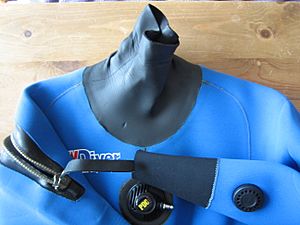Neoprene facts for kids

Neoprene is a special type of synthetic rubber. It is also known as polychloroprene. Scientists make it by joining together many small units of a chemical called chloroprene. Neoprene is very strong and can handle many different chemicals. It also stays flexible in both hot and cold temperatures.
You can find neoprene as a solid rubber or as a liquid called latex. It's used in many everyday items. These include laptop sleeves, special braces for body parts like wrists and knees, and electrical insulation. It's also used in car fan belts.
Contents
What Neoprene Is Used For
Neoprene is a very useful material. It lasts longer than natural rubber or other synthetic rubbers. This makes it perfect for tough jobs.
Everyday Uses of Neoprene
Neoprene is great for things like gaskets, hoses, and special coatings that stop corrosion (rust). It can also be used to make adhesives (glues). It helps reduce noise in large power transformers. Neoprene is also used as soft padding inside metal cases. This protects what's inside and makes sure it fits snugly.
Neoprene doesn't burn as easily as other rubbers. Because of this, it's used in weather stripping for fire doors. It's also found in gear for soldiers, like gloves and face masks. Neoprene can handle extreme conditions. This is why it's used to line landfills. Neoprene starts to burn at about 260 °C (500 °F).
When it's new, neoprene is a very bendy, rubber-like material. It can also keep things warm or cool, much like other plastics.
Neoprene Foam
Neoprene foam is used in many ways. It comes in two main types: closed-cell and open-cell.
- Closed-cell foam is waterproof. It doesn't squish much and costs more.
- Open-cell foam can let air through, making it breathable.
This foam is made by bubbling nitrogen gas into the rubber. The tiny gas bubbles are trapped inside. These bubbles help the material insulate. Nitrogen gas is used because it doesn't react with other chemicals. It also resists flames and works well in many temperatures.
Neoprene in Building
In building projects, neoprene is used as a strong base. It's often placed between two concrete or steel parts. This helps to spread weight evenly from one part to another.
Neoprene in Water Sports
Neoprene is very popular for making clothing for water activities. Foamed neoprene is often used for fly fishing waders and wetsuits. It keeps people very warm in cold water.
The foam is quite floaty. Divers need to wear weights to go deeper underwater. Thick wetsuits for very cold water are usually 7 mm thick. Because neoprene foam has gas pockets, it gets thinner under water pressure. A 7 mm wetsuit offers less protection at 100 feet deep than at the surface.
A newer type of neoprene is "super-flex." It mixes spandex into the neoprene. This makes the wetsuit much more flexible.
Neoprene waders are usually about 5 mm thick. They are a good middle-price option. Cheaper waders are made of nylon. More expensive ones use waterproof, breathable fabrics.
Wetsuits for competitive swimming are made from very expanded foam. They must be super flexible so swimmers can move freely. However, these suits can be quite delicate.
Neoprene for Your Home
Recently, neoprene has become popular for home items. This includes laptop sleeves and tablet holders. You can also find it in remote control covers and mouse pads. It's even used in cycling shorts. Sometimes, it competes with another material called LRPu. LRPu is tougher but not used as often.
Neoprene in Music
The Rhodes piano is an electric piano. Around 1970, it started using hammer tips made of neoprene. Before that, it used felt hammers.
Neoprene is also used for parts of speakers. It's also found in pads used for practicing drums.
Neoprene in Gardening
Hydroponic and aerated gardening systems use small neoprene pieces. These pieces hold plants in place. They are used when growing new plants from cuttings or with net cups. The inserts are small, from about 1.5 to 5 inches (3.8 to 12.7 cm).
Neoprene is good for holding plants because it's flexible and soft. It holds plants securely without hurting their stems. Neoprene root covers also block light from the plant's roots. This helps roots grow better and stops algae from growing.
Neoprene in Cars
In the car industry, neoprene is often used for car seats. It's also used for car seat covers. Many car makers offer neoprene seats as an option. This gives extra protection to the seats. These seat covers are also popular for people who are very active. Neoprene has a rubber layer that protects seats from moisture.
Other Cool Uses
Neoprene is used for Halloween masks and other face protection masks. It helps insulate parts inside computers, like CPU sockets. It's also used in waterproof car seat covers. You can find it in liquid and sheet materials for roofs. A mix of neoprene and spandex is used to make harnesses for wheelchairs.
Because it resists chemicals and lasts a long time, neoprene is sometimes used for dishwashing gloves. It's a good choice instead of latex. In fashion, famous designers like Gareth Pugh and Vera Wang have used neoprene. This trend became popular around 2014.
Images for kids
See also
 In Spanish: Neopreno para niños
In Spanish: Neopreno para niños




